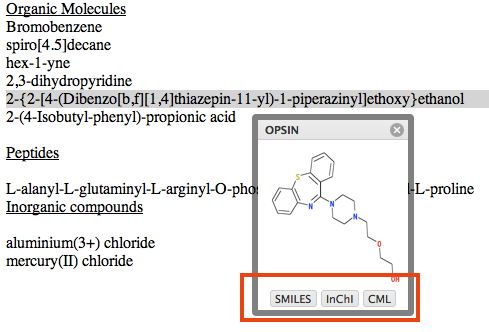Very pleased to see an announcement from Chris Swain who has ported OPSIN, out chemical name2structure processor to Safari. See http://homepage.mac.com/swain/Sites/Macinchem/Extensions/opsin_extension.html
Opsin Extension
The Unilever Centre for Molecular Science Informatics have been at the forefront at developing tools for the creation and curation of molecular data.
OSCAR
(Open Source Chemistry Analysis Routines) is software for the semantic annotation of chemistry papers a key part of this is
Opsin
a name to chemical structure converter. There is now a web interface to the program available and the web services can be accessed by anyone. Whilst this is very useful in its own right the beauty of such services is that other can build tools that access them.
There are a number
Safari Extensions described
on this site that access similar services and with the help of
Matt
I’m happy to anounce a new addition.
The Safari Extension for Opsin (download) allows the user to highlight a chemical name in a web page and then control click affords a dropdown menu, click on “Display … using Opsin” and a small window will open displaying the chemical structure. What is particularly nice is that in addition to providing the structure in png format the same web service also provides the chemical structure in SMILES, InChi and CML format. If you click one of the buttons and the bottom of the structure window the structure will be downloaded in the appropriate format. 
The great thing about this is that there is no legal barrier to building Open Source applications on top of other OS ones. OPSIN is actually a great platform for volunteers. Daniel has done very well in building all the major internals and the (relatively small amount of) remaining gaps are mainly filling in vocabulary. So we’d love to have offers of help.
What Chris has shown is how well-designed apps can be put together. There’s other ways of getting info into OPSIN besides typing – see if you can guess what they are and whether you have the skills to implement them. (We’ve built a prototype of one, but the others still await hacking).